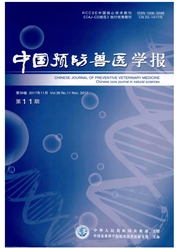

 中文摘要:
中文摘要:
A/Puerto Rico/8/34(H1N1)(PR8)是高滴度鸡胚适应流感病毒株,WHO 1969年将其推荐为流感病毒疫苗株内部基因供体株,本世纪以来其也被广泛用于H5N1流感疫苗株的内部基因供体株。本研究利用反向遗传技术以携带PB2基因K627E突变的PR8内部基因为骨架,以一株H7N9亚型低致病力禽流感病毒CK/HN的表面基因为供体,并在其HA基因引入V186G和L226Q双点突变,构建了一株重组病毒H7N9(HN)/PR8。固相ELISA受体结合特性分析结果显示,野生病毒CK/HN可同时结合α-2,6-糖链(人源受体成分)和α-2,3-糖链(禽源受体成分),并且与前者的亲和力高于后者;重组病毒H7N9(HN)/PR8对α-2,3-糖链的亲和力明显增高,对α-2,6-糖链的亲和力则显著下降。以10~6鸡胚半数感染量(EID50)接种SPF鸡后,CK/HN病毒可在鸡体内复制,通过呼吸道和泄殖腔向外排泄,感染鸡血清均转阳;H7N9(HN)/PR8接种的鸡泄殖腔和呼吸道均无病毒排出,也无血清转阳,表明H7N9(HN)/PR8病毒不能在鸡体内复制。本研究为H7N9疫苗株的构建奠定了重要基础。
 英文摘要:
英文摘要:
Chicken embryo-adapted A/Puerto Rico/8/34(H1N1)(PR8) virus was recommended to be used as the donor of internal genes for influenza vaccine strain construction by the World Health Organization in 1969,and the virus has also been widely used for the construstion of H5N1 avian influenza vaccine strain.In this study,we generated a reassortant virus,H7N9(HN)/PR8,that has the HA and NA genes of a low pathogenic H7N9 virus CK/HN and the internal genes of PR8 virus by reverse genetics.Two mutations,V186G and L226Q,were introduced into the HA gene,and K627E mutation was introduced into the PB2 gene in H7N9(HN)/PR8.We then tested the receptor binding property and replication in chickens of the CK/HN virus and H7N9(HN)/PR8 virus.We found that the CK/HN virus bound to human-type receptor with higher affinity than that to the avian-type receptor;the H7N9(HN)/PR8 bound to avian-type receptor with high affinity,but its affinity to the human-type receptor is very low.The CK/HN virus replicated efficiently in chickens and virus shedding could be detected in both oropharyngeal and cloacal swabs;however,the replication in chickens of the H7N9(HN)/PR8 was completely eliminated.Our study could provided important information for the construction of a safe H7N9 vaccine seed virus construction.
 同期刊论文项目
同期刊论文项目
 同项目期刊论文
同项目期刊论文
 期刊信息
期刊信息
